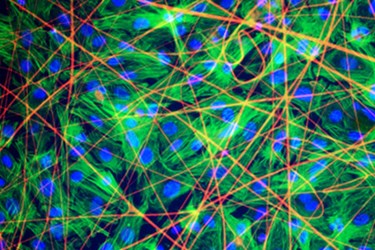Functioning Heart Tissue Grows On Spider Silk Substrate

Scientists have developed a new method of growing cardiac tissue using the protein spidroin, which is found in cobwebs. They believe spidroin may be a viable substrate candidate on which to grow a genetically engineered heart.
Recent research in regenerative medicine has sought to circumvent the problems that plague donor organ transplants by cultivating a new organ from the patient’s own stem cells. In order to successfully engineer functioning tissue, researchers must provide a biocompatible scaffolding to which growing cells can adhere and that safely degrades once the tissue has fully formed.
According to a study published in the journal PLOS One by a team from the Moscow Institute of Physics and Technology State University (MIPT), successful cardiac tissue scaffolds must provide particular characteristics. First, they must be elastic enough to host working cardiac tissue. They must also provide an environment conducive to the electrophysiological unity of the cardiac cells.
In the study, the MIPT team introduced scaffolding made from electrospun fibers of the protein spidroin derived from genetically modified yeast cells. They then attached neonatal rat cardiomyocytes to the scaffold and monitored their growth through a microscope. Within three to five days, the cells were able to contract synchronously and conduct electricity just like functioning heart tissue.
In their conclusion, the study authors reported that “these substrates are suitable directly for the cardiomyocytes attachment and growth without additional coating with the attachment factors, such as fibronectin.”
A study published last year by Journal of Materials Research noted the benchmarks of spider silk research of the last five years and growing interest in its possible biomedical indications. Authors of that study noted that, “Progress in protein synthesis, notably the expression of full-size spidroins, has driven substantial improvements in synthetic spider silk performance.”
According to a MIPT press release, spidroin fibers are five times stronger than steel and offer double the elasticity of nylon while maintaining an extremely lightweight structure. Though similar to fibroin, which is derived from silkworms, researchers note that spidroin is much more durable.
“They incorporate great cell adhesion properties, excellent mechanical strength, and impressive elasticity,” the researchers wrote of spidroin in their PLOS One paper. They also pointed out that while spidroin has been used to grow bones, tendons, cartilage, and wound dressing, this is the first instance of using it to grow cardiac tissue.
Konstantin Agladze, head of the Laboratory of the Biophysics of Excitable Systems at MIPT and study leader, said in MIPT press release that his team had successfully answered all questions put forth by their study.
“Cardiac cells successfully adhere to the substrate of recombinant spidroin; they grow forming layers and are fully functional, which means they can contract coordinately,” he said.
Image of heart tissue cells grown on a matrix, stained with fluorescent markers © Alexander Teplenin et al. / PLOS ONE.
